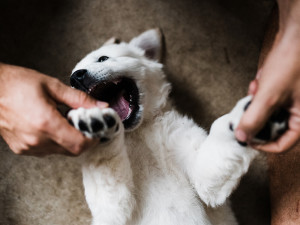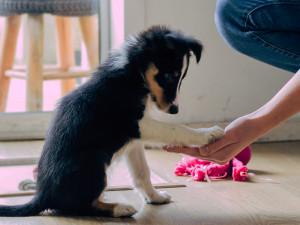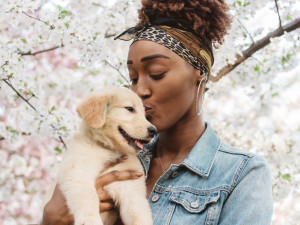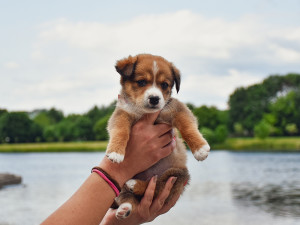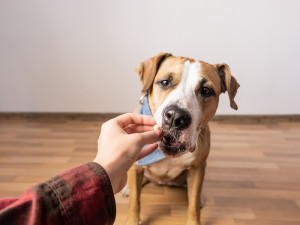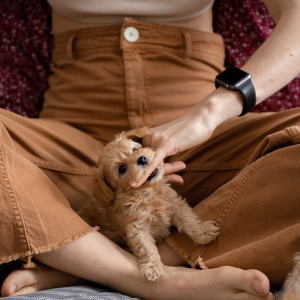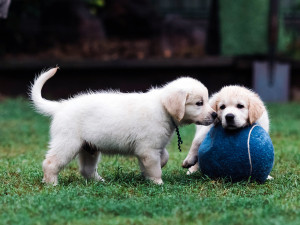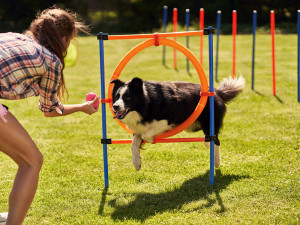Dog Life Stages: Puppy Adolescence Is Only a Phase
What to expect when your perfect puppy hits that unruly stage

Share Article
Dog adolescence is only a temporary phase. It brings about challenging behavioural changes that are reminiscent of human teenage years, but it catches many people off guard because they are not expecting it. I regularly have clients ask me, “Why didn’t anybody warn me?” It’s a fair question.
The answer is that most people don’t think much about the effect of age on dogs’ behaviour. Sure, there are a few exceptions: most people realise that puppies can’t control their bladders as long as adult dogs (even if house-training is progressing well and the pup seems to grasp the basic idea that the loo is outside). It’s also generally accepted that dogs in their golden years tire more easily (so that strenuous, three-hour hike should be reconsidered).

littleKin™ is Kinship’s home just for puppy and kitten parents. Bop over to check out expert advice, new pet tools, and special deals—all curated for your newest family member.
opens in a new tabThere are many dog life stages in between the times that dogs are very young and very old, and dogs’ behaviour is influenced by their age a lot. The influence of age on behaviour is not often taken into account, and that makes adolescence a surprise to many people. It’s only a phase, and that’s worth remembering when you find yourself dealing with the inevitable misunderstandings and frustrations of life with an adolescent dog. Forgetting this stage is only temporary will be counterproductive to developing and enjoying a close relationship. In fact, relationships between people and dogs can be tested during adolescence, and it’s no coincidence that dogs are the most vulnerable to being surrendered to shelters and rescues at this stage.
What are the life stages of a dog?
The dog lifespan encompasses a number of dog life stages. For the first six to eight months of life, they’re puppies. Then from six to eight months until about the age of 18 months to two years, they are adolescents. From that point, until they are 75 percent into their expected life span (which varies by size and breed of dog), they are adult dogs. For the last 25 percent of their expected lifespan, they are considered senior dogs, when they are also said to be in their golden years, or referred to as ‘grey hairs’.
What are the adolescent years for dogs?
The adolescent years for dogs are the end of their first year until somewhere between halfway and fully through their second year of life. Sometimes, people refer to ‘puppy adolescence’, but the adolescent phase is a separate time of life that comes after the puppy phase. The dog adolescent ages are the ones that many people find the most challenging.
That is saying something because the puppy phase is the one that usually involves potty messes and sleep deprivation, yet it is still not as hard for most people as the adolescent phase.
The dynamic between adult and adolescent dogs
Adult dogs respond differently to dogs of other ages, so this dog life stage matters to dogs, too, and not just to people. Some adult dogs are disinterested or afraid of puppies, but it’s common for stable and well-adjusted dogs to have an indulgent attitude towards puppies. Many adult dogs let puppies crawl all over them, bite or bat at their tail and ears, take their toys, and disturb them no matter what they are doing.
But then the ‘puppy licence’ wears off when the puppy reaches early adolescence, and dogs are less likely to tolerate certain behaviour from young dogs. They are very clear about what is acceptable and what is not, and they set clear boundaries. Adults shouldn’t be too rough, and usually aren’t, but some adolescents do become alarmed by the sudden change in the behaviour towards them by adult dogs.
This change involves adult dogs who react very differently. It’s not only normal – it’s desirable. There’s no better way for a young dog to learn some manners than to have a socially skilled adult dog set clear boundaries.
Humans also do this boundary-setting. When a baby grabs at earrings or pokes an adult in the eye, the adult’s response is minimal. But a seven-year-old who does this is likely to receive instruction on appropriate behaviour. Ideally, such instruction is given kindly and fairly to young humans and young dogs alike.
The dog adolescent phase: what to expect
When your dog enters adolescence, expect behavioural changes. It’s completely normal for them to act differently as they enter the transitional period between puppyhood and adulthood. Transitions of any kind are hard, and this is true with developing dogs.
Just like human adolescents, dogs can have a mild or extreme experience with their transitional years. As a pet parent, this period can be a shock, since it comes right on the heels of the adorable puppy stage. Sure, during a dog’s puppyhood there are usually some accidents and interrupted sleep, but your puppy’s cuteness largely distracts you from viewing this as a terrible part of dog parenthood. People are rarely blindsided by the trials and tribulations of puppyhood – nobody is surprised by the occasional chewed-up shoe.
Not so in adolescence. This is the time when many of the kindest, most patient dog parents in the world are left wondering where their sweet puppy has gone. There’s an understandable urge to say, ‘Who is this monster, and what have they done with my dog?’
What behavioural changes can I expect during dog adolescence?
1. Independence
People are often surprised by the sudden independence of their adolescent dog. Gone is the shadow pup whose first choice of where to be was always right next to you. Dogs emerging from the puppy stage tend to explore more, wander further from you than they used to and care less about keeping you in sight.
It’s hard to see your dog acting independently like this because it can feel like they don’t need you – or even as if they don’t love you as much. Don’t let it get you down: despite these behavioural changes, your dog loves and needs you just as much as ever, but also likes to do their own thing and follow their nose. (I don’t know who needs to read this again, but your dog still loves and needs you.)
2. Being less responsive to cues
Often, adolescent dogs seem to have forgotten everything you worked so hard to teach them. They ignore cues, respond to them more slowly, or act as though they forget what some of them mean at all. I know it’s difficult, but don’t take it personally. What feels like a training setback is completely normal in adolescence, so try not to settle into gloom and doom or feel like all is lost. Your puppy is just growing up, and this too shall pass.
Even if you know to expect it (and especially if you don’t), it can be quite a shock the first time your adolescent dog acts like they didn’t even hear you. It’s demoralising, after months of enjoying your gleeful puppy running to you when you cheerily call out, ‘Come’, to see no such enthusiasm. You gave the cue just like you have so many times before, you’re all ready to reinforce your dog with great treatsopens in a new tab or a chase game, and what happens? There’s no reaction – none at all, not even an ear twitch. Sigh. That perfect recall that brought you such pride seems to have disappeared.
The same dog who sat in a heartbeat when asked now looks at you as though considering their options. Yeah, I heard you, but I’m simply not interested in doing that right now. Don’t be surprised if you give a cue your dog knows well, and the response is a blank look, as though they’re completely unfamiliar with this cue or the behaviour associated with it.
Don’t panic when you see a training slump in early adolescence; it’s a common – and temporary – phenomenon. The work you’ve put in with your puppy will pay off later. The well-trained, responsive puppy is likely to mature into a well-trained, responsive adult, even if the adolescent in between bears little resemblance to either. As journalist and gossip columnist Earl Wilson quipped, “Snow and adolescence are the only problems that disappear if you ignore them long enough.”
3. Increased fearfulness
As dogs approach the one-year mark, many temporarily become more fearful. Dogs who begin to act skittish or nervous but were previously confident are probably entering this developmentally normal fear period. They may shy away from people with hats or sunglasses. A toddler shrieking and running towards them may prompt your dog to run the other way.
Most dogs move past this fear period without any lasting effects, just as kids stop being afraid of monsters under the bed once they move past that developmental stage. We can help all our dogs cope better by staying calm, resisting the urge to panic, and talking to the dog in a cheerful way. Don’t force them to approach or interact with anything or anyone that unnerves them, and pair up their triggers with something that makes them happy such as great treats or toys.
4. Adult dogs setting clear boundaries
Some sweet adult dogs indulge puppies by doing nothing when the little one nibbles on their ears or bats at their nose; takes their toy or uses their tail like one; or tries to play when the adult dog is clearly ready for a snooze. When the puppy approaches adolescence, the adult dog is likely to let their young friend know that this behaviour is no longer acceptable, perhaps growling if the younger dog is being a pest, using their paw to swat at them, or even nipping with a gentle bite over their muzzle.
Most young dogs quickly learn what is allowed and what is not. An adult dog who gently offers young dogs a good social education is an asset. ‘Gently’ is a crucial word here. It’s essential that the adult strikes the right balance – firm but not rough. The adult dog should be guiding the younger one, never scaring or hurting them, but simply letting them know there are new expectations about how to act now.
Dog behaviour is not static
Many behavioural differences are predictably related to age, with especially big changes occurring during adolescence. They’re easier to handle if you recognise these changes for what they are: a normal part of development. We naturally do this with humans, but often fail to give the same courtesy to dogs. Adult dogs understand the change from puppyhood to adolescence and react accordingly. Perhaps the best course of action is to follow their lead.
How can I handle my dog’s changing adolescent behaviour?
It takes patience and an adjustment of expectations to handle your adolescent dog’s challenging behaviours. Being patient here really just means giving your dog a lot of grace and remembering that adolescence is temporary, but the love you share is forever. Dogs at this age have busy brains and they are easily distracted. They are not ignoring you on purpose; they are so tuned in to the world around them and they simply don’t have the bandwidth to give you the attention you became accustomed to in the puppy stage, and that you will see again as they mature.
Many adolescent dog behaviour problems are a simple result of a dog exploring their new world with more confidence and excitement than they had as a puppy. Remembering that your dog is finding joy in the world can help you to accept who they are at this point in their lifespan. Then, when they enter the next of the dog life cycle stages (young adulthood) they will enter it with a parent whose patience and love has kept the relationship strong.
References

Karen B. London, PhD, CAAB, CPDT-KA
Karen B. London, Ph.D., is a Certified Applied Animal Behaviorist and Certified Professional Dog Trainer who specializes in working with dogs with serious behavioral issues, including aggression, and has also trained other animals including cats, birds, snakes, and insects. She writes the animal column for the Arizona Daily Sun and is an Adjunct Professor in the Department of Biological Sciences at Northern Arizona University. She is the author of six books about training and behavior, including her most recent, Treat Everyone Like a Dog: How a Dog Trainer’s World View Can Improve Your Lifeopens in a new tab.
Related articles
![Two Golden Retriever puppies playing with a large blue tennis ball outside in the grass]() opens in a new tab
opens in a new tabWhat to Expect At Puppy Socialisation Classes
A dog behaviourist schools us on why puppy classes are more about socialising than getting straight As
![woman gives small black dog treat for sitting]() opens in a new tab
opens in a new tabYour Dog Should Do This 30-Day Training Challenge
It’s like your 30-day yoga challenge – except with way more training treats
![]()
How to Teach Your Dog to ‘Talk’ at the Touch of a Button
Cognitive science professor Dr Federico Rossano on how Bunny, TikTok’s ‘talking’ dog, is sparking change in how we communicate with our pets
![Border collie dog and a woman on an agility field]() opens in a new tab
opens in a new tabA Crash Course On Dog Agility Training
Five reasons to get your dog in the agility game, from burning energy to building confidence

